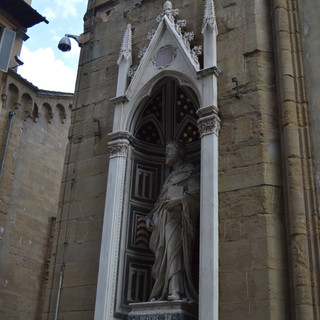Orsanmichele: From Grains to Riches
- Taylor Girtman
- May 28, 2018
- 3 min read
Updated: Jun 27, 2018
When you walk down Via Dell’Arte Della Lana, you will pass by hundreds of stores and cafes bursting with tourists and Florentines. Amidst the bustle is Orsanmichele, a church that was completed in 1404. However, what is most interesting about this ordinary looking church is its original purpose – a grain mill.
The church is located on Via dell'Arte della Lana near the center of Florence and the Piazza della Signoria. The best part of visiting this church is the free entrance for all visitors. The church is open Tuesday through Thursday from 10 a.m. to 5 p.m. Orsanmichele also has a museum with statues of saints and Roman historical figures that is also free and only open on Mondays.

The exterior of the church is unique, not only because of its location in a bustling area of town, but because thirteen of the fourteen statues built into the church are originals. Only one is a reproduction of St. George. In total, there are fourteen statues: four on two sides, three on the front and three on the back. Because the church hasn’t been fully restored, copies of the statues have not been created yet. Below, photos show statues of St. Peter and Galileo along one side of the building.
In the 8th century, a small church was built for San Michele, but the building was demolished in the 11th century, according to information inside the current church. Later a new building was built dedicated to the sale of grain, in addition to continuing as a church, until a fire damaged the building shortly after in 1304. Organizations called guilds during this time served to support businesses and generate a prosperous economy. A guild built a new facade to be used as both a church and a market, however, by 1357 the grain market had moved to a new location, according to Museums in Florence.
The church is divided into two main sections by an aisle. On the left side is the St. Anne Altar Statue by Francesco da Sangallo that was built in 1526. The right side faces the tabernacle built by Andrea Orcagna in 1359. The center of the tabernacle holds a portrait of Madonna by Bernardo Daddi from 1346.

Stained glass windows cover the tops of the church walls. They are very colorful and show various Biblical stories. Ten sets in total are seen only from the interior of the church; from the exterior these windows look like ordinary glass.
The architectural style of the church is historically gothic. According to Museums in Florence, the squared layout of the church resembles the original loggia layout of the grain mill. Large posts not only support the building's structure but act as dividers for the large church space.
Though the exterior statues have not been restored, other statues from the building have been and are located in the adjacent Orsanmichele Museum. The museum includes only sculptures of saints and other important Roman or Italian historical figures. These statues have been restored one by one and moved to the museum.

Though the museum is only open on Mondays, it continues the gothic architecture throughout its interior. The church uses gothic architecture also in its ceiling structure. Large arched ceilings are seen in many other historical buildings across Florence. The pointed designs above each of the exterior statues also resonate with gothic design and are similar to details seen in famous gothic buildings like the Cattedrale di Notre-Dame in Paris.
Gothic architecture was first introduced in the Middle Ages, according to Brittanica, and the style includes pointed arches, rib-vaulted ceilings and stained glass windows to allow as much light in as possible. Differing from French or German gothic architecture's use of stone, Italians used brick and marble in their buildings. Examples of these gothic architectural details are pictured below.
Orsanmichele not only holds a great deal of architectural history, but the building holds its own unique history as well. From a grain mill market to a gothic church, Orsanmichele Church is definitely worth visiting during your time in Florence.



















Comments